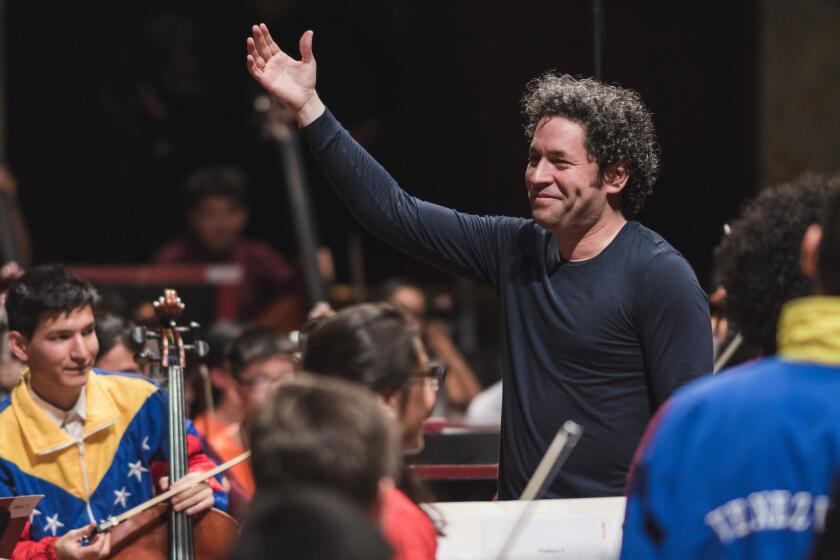CRITIQUE : Where Bigger Is Better : Convention Center’s Expansion Succeeds
- Share via
When the Los Angeles Convention Center was built in the early 1970s, such structures generally tended to be unpretentious basic boxes enclosing a large raw space hidden away on the urban periphery.
However, in the mid-1980s convention centers began to change character. Following the opening of New York’s Jacob K. Javits Center in 1986, these vast exhibition halls grew even larger. At the same time they became more consciously crafted as architecture and as elements of urban design.
Now the Los Angeles Convention Center itself has been transformed. It has been more than doubled in size, from 1.5 million to 4 million square feet, jumping across Pico Boulevard to occupy a site at the junction of the Harbor and Santa Monica freeways.
Its sophisticated green-glass and white-steel facade has now become a major presence on Figueroa Street, enlivening a rundown section of South Park. And the expanded Convention Center has become a gateway building marking the southwest entry to the downtown district.
Designed by James Ingo Freed of New York-based Pei Cobb Freed & Partners in collaboration with L.A.-based Gruen Associates at a cost of $500 million, the new Convention Center skillfully and gracefully rises to the challenge of several planning and design problems presented by the site.
To start with, the original Convention Center site north of Pico Boulevard was too small to accommodate the major expansion required by the Los Angeles Convention and Exhibition Authority. The authority’s mandate was to upgrade the old center to make Los Angeles more competitive with other cities in Southern California and across the United States as a venue for large-scale conventions.
The decision was made to expand on the site south of Pico and link the two halves with a 240-foot-wide bridge over the boulevard. As a consequence, the floor of the new main exhibition hall had to be lifted up above street level to create an even pedestrian flow over the bridge and into the second-floor-level existing hall.
“To function smoothly, a convention center must provide a clear internal circulation, without the inconvenience of having to go up and down stairs,” said Freed, whose reputation as a convention center architect derives from his design for the massive Javits Center. “So our layout was driven by the smooth movement of people through its spaces.”
Having lifted the exhibition hall off the ground, the architects made a feature of the large staircase lobbies needed to connect them with the street level. The South Lobby, located on the southwest corner of Pico and Figueroa, is a 150-foot-tall pavilion of white-painted steel-pipe columns and beams sheathed in teal-green glazing. The slightly lower West Lobby, fronting the old exhibition hall, is set back from a five-acre outdoor exhibition plaza planted with palms, willows and ficus trees.
*
These lobby towers also serve to articulate the Convention Center’s long, low frontage on Figueroa. Flanked by external fire escape stairs enclosed in nautical railings, the towers look rather like the smokestacks of an ocean liner docked alongside the street. This enhances Freed’s concept of the center as “an architecture of movement.”
In the placement of the South Lobby tower the architects have cleverly exploited the change in direction of Figueroa Street south of Pico. The tower marks this kink in the street grid and also acts to attract the eye from the heights of Bunker Hill.
The back wall of the new expansion sweeps around in a wide curve following the line of the adjacent freeway deck. Painted a vivid green, with a purple canopy over the back entry loading dock, this curved, aluminum-paneled surface is a bravura design gesture that matches the massive scale of the freeways.
Scale is skillfully handled throughout the Convention Center. The long street facade has crisp and lively detailing in its steel-and-glass surfaces. The lobby tower interiors are muscular but friendly. The signage, crucial in helping visitors find their way around so large a facility, is bold and easy to follow.
The Convention Center expansion has added the new 350,000-square-foot South Exhibit Hall, a 26,000-square-foot Concourse Hall, 42 new meeting rooms, a 299-seat theater, two new restaurants and 3,650 extra parking spaces, for a total of 6,000. There are also 34 new loading docks and an internal road system for trucks, shuttle buses and taxis.
The two large exhibit halls, which form the core of the center, remain little more than raw space. The necessity to provide maximum flexibility for a range of shows, and the freedom to invent their own scenarios that exhibition designers demand, keeps these halls as blank as possible. To serve these requirements the exhibit hall walls are dull gray aluminum topped by a ceiling of black metal mesh hiding the overhead services. The floors are plain cement.
*
Internally, the building’s finishes are sleek and simple. The lobbies are floored in colored terrazzo with an embedded design by artist Alexis Smith. Elsewhere, the floors are covered in gray carpet, and the walls are painted white. The one major lapse in this otherwise excellent building is the rather offhand way the overhead bridge relates to Pico Boulevard. The opportunity to make the bridge into a real urban gateway has been ignored. As a result, the stretch of street under the bridge looks more like a brief tunnel than a welcoming arch.
The Convention Center’s development has had its downside. Some 1,500 people had to be moved and rehoused elsewhere in the city to clear the 63-acre site. Despite this act of forcible slum clearance, the perception that this corner of South Park is still crime-ridden and inhospitable has made it difficult to attract an operator for the big hotel planners hoped would be built across Figueroa Street.
This means that all out-of-town Convention Center visitors will have to accept the inconvenience of a shuttle connecting them with the hotels in upper downtown.
Overall, however, the new Convention Center has triumphed over the problems of its location and the complications of its site. It anchors the southern end of the Figueroa Street corridor leading down from Bunker Hill and adds a real sparkle to dull corner of downtown.
More to Read
The biggest entertainment stories
Get our big stories about Hollywood, film, television, music, arts, culture and more right in your inbox as soon as they publish.
You may occasionally receive promotional content from the Los Angeles Times.










